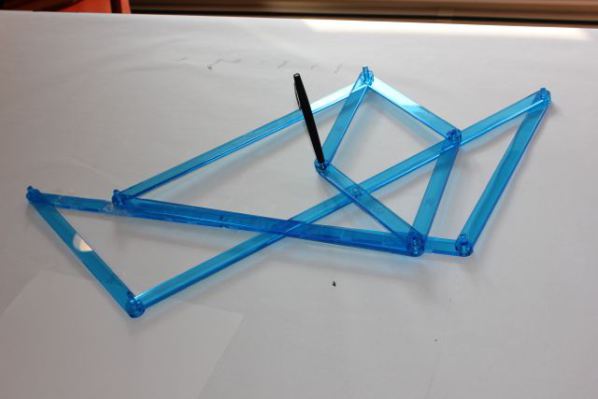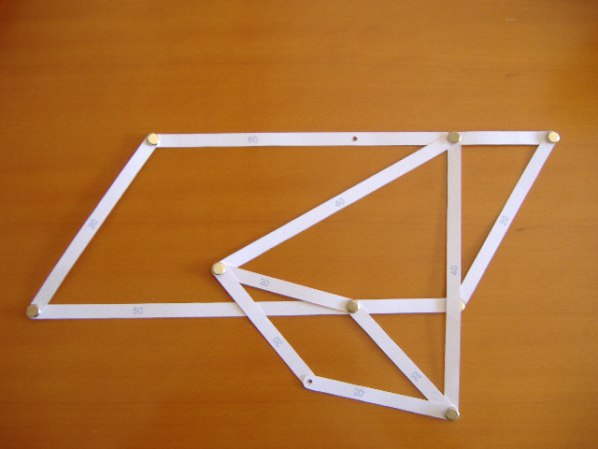Math Monday: Linkages – Give ’em the Second Degree
by Gareth Branwyn
This is another installment in our epic Math Monday series on the intricate world of mechanical linkages. See the Linkages series introduction for the MoMath Linkage Kit, an introduction, and general instructions.
So, by now we’ve seen linkages that trace out curves described by fourth degree polynomials, and sixth degree polynomials, and most recently, lines: "curves" of degree one. So, the natural question: is it possible to trace out a curve of degree two? Indeed, it is, and this column gives you a linkage for a parabola. Interestingly, like the Peaucellier linkage for a straight line, this linkage depends on the technique of inversion in a circle. In fact, you should be able to see a copy of the Peaucellier linkage embedded in this one. It’s the most complex linkage in this MoMath series.
Parabola Linkage
Ingredients: Two 60-bars with a hole at 45 (A and C); two 30-bars (B and D); two 40-bars (E and F); four 20-bars (G, H, I, and J); and a pen.
Directions: Fix A horizontally. Link A-60 to B to C-0. Link C-60 to D to A-0, making sure to cross C over A. Link A-45 to E and F. Link the far end of E to G and H. Link the far end of F to I and J. Link the far ends of H and J to C-45. Link the far ends of G and I with a pen.
To use: Rotate B left and right as far as it will go, keeping the pen in the hole drawing on the paper.
Here’s a picture of the completed linkage: A reminder — be careful to cross the two 60-bars as in the above picture. You don’t want the first four bars to form a parallelogram. In other words, you don’t want your linkage to come out looking like this paper model:
A reminder — be careful to cross the two 60-bars as in the above picture. You don’t want the first four bars to form a parallelogram. In other words, you don’t want your linkage to come out looking like this paper model: And finally, here’s the parabola linkage in action, drawing a rather lovely curve:
And finally, here’s the parabola linkage in action, drawing a rather lovely curve: For a real Math Mondays challenge, work out why this linkage produces a perfect parabola. You can also find linkages on the web for the other conic sections: ellipses and hyperbolas. (The linkage for a circle was covered in the very first column: it’s the 1-bar linkage known as a “compass”.)
For a real Math Mondays challenge, work out why this linkage produces a perfect parabola. You can also find linkages on the web for the other conic sections: ellipses and hyperbolas. (The linkage for a circle was covered in the very first column: it’s the 1-bar linkage known as a “compass”.)
This article first appeared on Make: Online, January 28, 2013.

